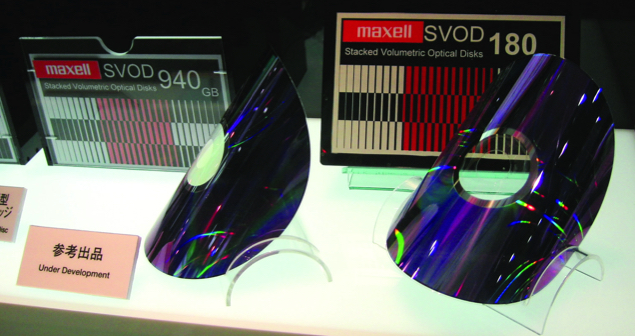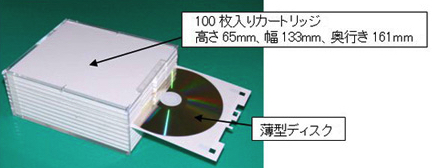History (1993): Hitachi Working on Optical Disk Array
Using 5 magneto-optical fixed disks operated from the same central axis
By Jean Jacques Maleval | August 24, 2020 at 2:19 pmMémoires Optiques et Systèmes, a French publication, announced that Hitachi, with its subsidiary Maxell, and Nippon Columbia has developed a storage subsystem to answer the needs of mainframe users, the SOD or Stacked Optical Disk.
Pictures of final version published in 2006


Unlike other products, actually offered on the market, Hitachi’s solution doesn’t use removable media, but 5 magneto-optical fixed disks operated from the same central axis. With a 10-inch diameter, each one can store 6GB on one side and are read by 5 or 10 small optical mobile heads, all the heads are independent from each other and placed on two separate HDAs. The prototype offers a total storage capacity of 3GB with an average access time of 90ms. With a 3,600rpm rotational speed, it offers a 64MB/s transfer rate. Each optical head can be addressed separately or synchronously when it uses the disk array technology.
The high density of these magneto-optical disks has been reached by a change in the size of the tracks and the recording pits. The SOD system uses media with 1.4μ pre-engraved tracks and a writing technology that just prints .56μ “spots” to write one bit.
The use of two independent heads per side enables data to be overwritten directly on the disk. The first one erases previous information when the second one immediately writes the new data.
Here, the entire optical media head set has been studied over. The engineers not only developed the mechanical parts but a new media. It is made with a glass substrate covered with an optical structure that is very sensitive to the infrared laser beam. The laser recording power doesn’t exceed 8mW despite a 45m/s rotational speed. This new type of optical disk answers the mass storage requirements related to computers or digital video systems that require heavy throughputs.
Some derived products offered as packs of digital optical disks are being developed by a few manufacturers to add removability.
This concept is not new. It was patented, over 8 years ago, by a US company, Resolution Research Inc. and is also used by searchers of the Institute of Automation & Electrometry in Novossibirsk in Siberia.
It is a trend for optical disks that should be kept in mind as it offers an alternative to chained multi-drives and LMSI LD-4500 or ATG Gigafeeder type autochangers.
This article is an abstract of news published on the former paper version of Computer Data Storage Newsletter on issue ≠61, published on February 1993.
Note: This products never appears on the market;














 Subscribe to our free daily newsletter
Subscribe to our free daily newsletter


